 Technology peripherals
Technology peripherals
 AI
AI
 AI painting infringement is confirmed! Diffusion models may remember your photos and all existing privacy protection methods will be ineffective
AI painting infringement is confirmed! Diffusion models may remember your photos and all existing privacy protection methods will be ineffective
AI painting infringement is confirmed! Diffusion models may remember your photos and all existing privacy protection methods will be ineffective
This article is reprinted with the authorization of AI New Media Qubit (public account ID: QbitAI). Please contact the source for reprinting.
AI painting infringement is confirmed!
The latest research shows that the diffusion model will firmly remember the samples in the training set and "follow the example" when generating.
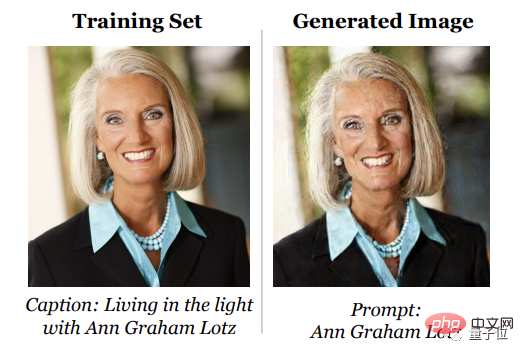
In other words, in the AI paintings generated by Stable Diffusion, behind every stroke there may be an infringement incident.
Not only that, after research and comparison, the diffusion model’s ability to “plagiarize” from training samples is twice that of GAN, and the better the diffusion model is generated, the stronger its ability to remember training samples. This research comes from a team composed of Google, DeepMind and UC Berkeley.
existing privacy protection methods are all invalid.
As soon as the news came out, netizens exploded, and the author of the paper's related Twitter retweets were about to exceed a thousand.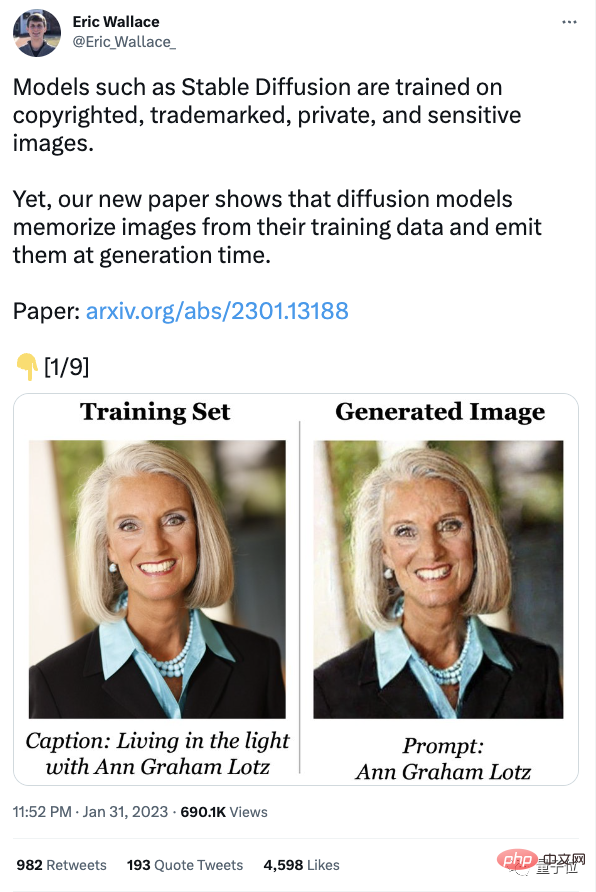

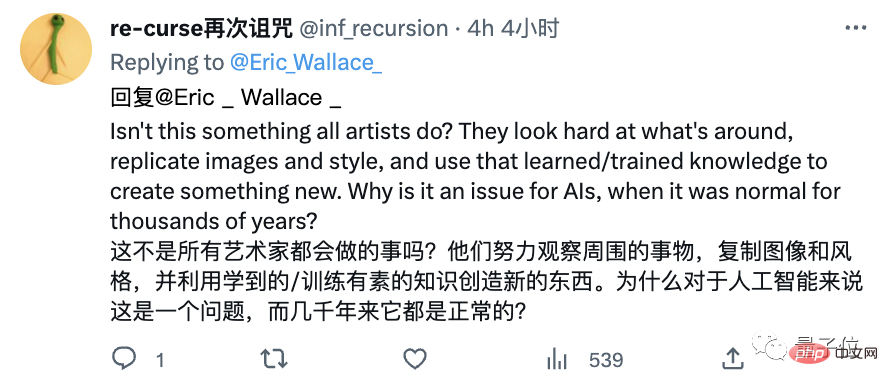
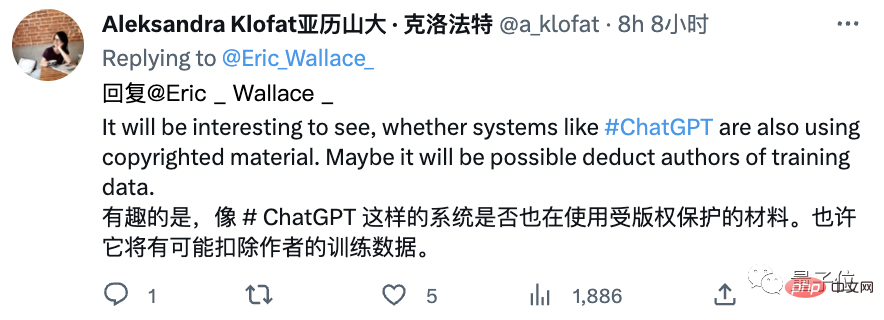
remember the images used for training, and finally "plagiarize" during generation?
The images in the training set are often obtained from the Internet. They are copyrighted, trademarked, and some are private, such as private medical X-rays. In order to figure out whether the diffusion model canmemorize and regenerateindividual training samples, the researchers first proposed a new definition of "memory".
Generally speaking, the definition of memory focuses on text language models. If the model can be prompted to recover a word-by-word sequence from the training set, it means that the sequence has been extracted and memorized. In contrast, the research teamdefined "memory" based on image similarity.
However, the team also frankly admits that the definition of "memory" is conservative. For example, the picture on the left is a "photo of Obama" generated by Stable Diffusion. This picture is not similar to any specific training image on the right, so this image cannot be counted as based on memory. generate.
two-stagedata extraction(data extraction attack).
The specific operation is to use standard methods to generate images, and then label those images that exceed the human reasoning scoring criteria. Applying this method on Stable Diffusion and Imagen, the team extracted more than 100 approximate or identical copies of training images. There are both identifiable personal photos and trademark logos. After inspection, most of them are copyrighted.
Then, in order to better understand how "memory" occurs, the researchers sampled 1 million times from the model and trained hundreds of diffusion models on CIFAR-10.
The purpose is to analyze which behaviors in model accuracy, hyperparameters, enhancement and deduplication have an impact on privacy.

Finally came to the following conclusion:
First of all, the diffusion model has more memory than GAN.
But diffusion models are also the worst private group among the image models evaluated, leaking more than twice as much training data as GANs.

Also, A larger model may remember more data.
With this conclusion, the researchers also studied the 2 billion parameter text-image diffusion model Imagen. They tried to extract 500 images with the highest scores outside the distribution and used them as samples in the training data set. They found that All are remembered.
In contrast, the same method applied to Stable Difusion did not identify any memory behavior.
Therefore, Imagen has worse privacy than Stable Difusion on copied and non-copied images. The researchers attribute the reason to the fact that the model used by Imagen has a larger capacity than Stable Difusion, so it remembers more images.
In addition, Better generative model(lower FID value)More data stored.
In other words, as time goes by, the same model leaks more privacy and infringes more copyrights.
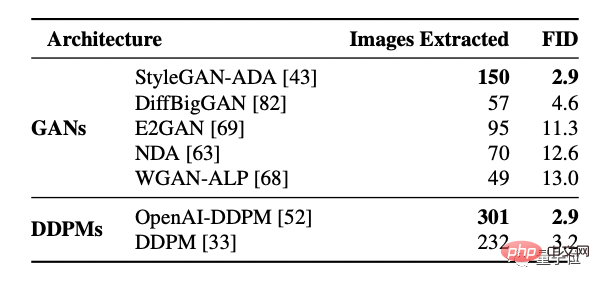
(GAN model sorted by FID, the lower the FID value, the better the effect)
Through training the model, the team found that Increasing utility reduces privacy , and simple defensive measures (such as deduplication) are not enough to completely resolve memory attacks.
Therefore, privacy-enhancing technologies do not provide an acceptable privacy-utility trade-off.
In the end, the team made four suggestions for those who train the diffusion model:
- It is recommended to remove duplicate data from the training data set and minimize overtraining;
- It is recommended to use data extraction or other auditing techniques to assess the privacy risks of the training model;
- If there are more practical privacy protection technologies, it is recommended to use them as much as possible;
- I hope that the pictures generated by AI will not The privacy-related parts will be provided to users free of charge.
The copyright owner has never stopped defending its rights
Once the research comes out, it may have an impact on the ongoing litigation.
At the end of January, the big brother of the gallery, Getty Images, (Getty Images) sued Stability AI in the High Court of London in the name of copyright infringement.
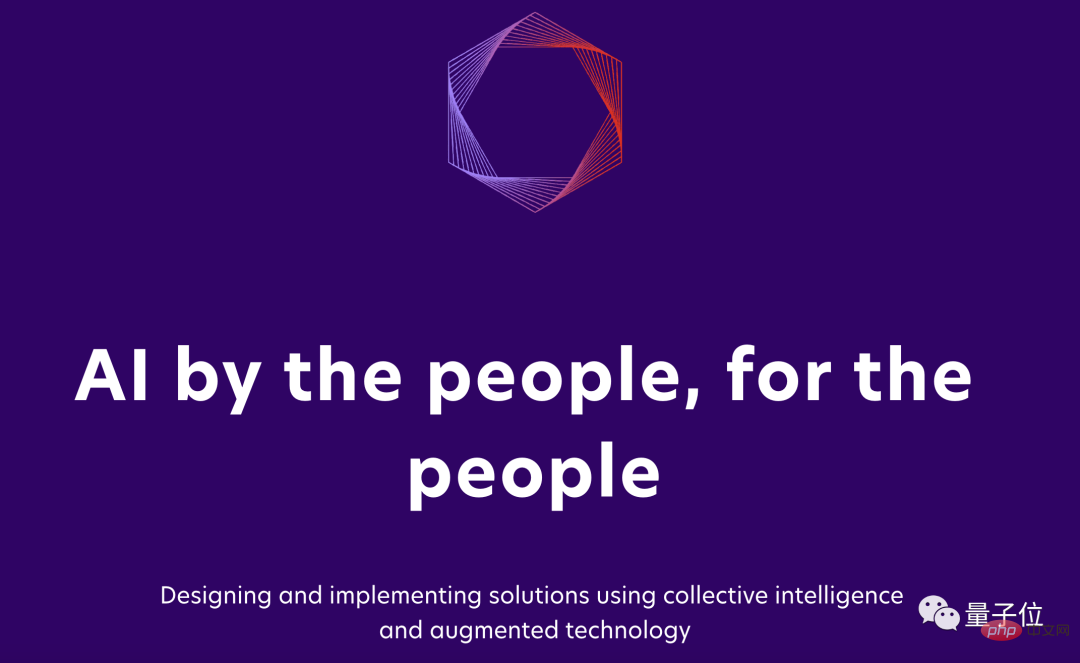
△Stability AI
Getty Images believes that Stability AI "illegally copied and processed millions of copyrighted images." Stable Difussion under the training name.
Part of the training data for Stable Difussion is open source. After analysis and inspection of watermarks, it was found that many photo agencies, including Getty, had unknowingly provided a large amount of material for Stable Difussion's training set, accounting for a large proportion.
But from the beginning to the end, Stability AI has never interacted with the photo agency.
Many AI companies believe that this practice is protected by laws such as the U.S. Fair Use Doctrine, but most copyright owners disagree with this statement and believe that this behavior infringes on their rights.
Although Stability AI has previously issued a statement saying that in the next version, copyright owners can delete their own copyrighted works in the training gallery, but at this stage it is still Some people are dissatisfied.
In mid-January, three artists had filed a lawsuit against Stability AI and Midjourney.
Legal experts also hold different opinions in order to reach a unified opinion, but they all agree that the court needs to rule on the issue of copyright protection.
Getty Images CEO Craig Peters said that the company has sent a notice to Stability AI, saying that "you will soon be sued in the UK"!
The company also said:
We do not care about the losses caused by infringement, and we have no intention to stop the development of AI art tools.
Taking Stability AI to court is not in the interests of our Getty family.
The choice to sue has a deeper long-term purpose, and we hope that the court will set new laws to regulate the status quo.
The above is the detailed content of AI painting infringement is confirmed! Diffusion models may remember your photos and all existing privacy protection methods will be ineffective. For more information, please follow other related articles on the PHP Chinese website!

Hot AI Tools

Undresser.AI Undress
AI-powered app for creating realistic nude photos

AI Clothes Remover
Online AI tool for removing clothes from photos.

Undress AI Tool
Undress images for free

Clothoff.io
AI clothes remover

Video Face Swap
Swap faces in any video effortlessly with our completely free AI face swap tool!

Hot Article

Hot Tools

Notepad++7.3.1
Easy-to-use and free code editor

SublimeText3 Chinese version
Chinese version, very easy to use

Zend Studio 13.0.1
Powerful PHP integrated development environment

Dreamweaver CS6
Visual web development tools

SublimeText3 Mac version
God-level code editing software (SublimeText3)

Hot Topics
 Open source! Beyond ZoeDepth! DepthFM: Fast and accurate monocular depth estimation!
Apr 03, 2024 pm 12:04 PM
Open source! Beyond ZoeDepth! DepthFM: Fast and accurate monocular depth estimation!
Apr 03, 2024 pm 12:04 PM
0.What does this article do? We propose DepthFM: a versatile and fast state-of-the-art generative monocular depth estimation model. In addition to traditional depth estimation tasks, DepthFM also demonstrates state-of-the-art capabilities in downstream tasks such as depth inpainting. DepthFM is efficient and can synthesize depth maps within a few inference steps. Let’s read about this work together ~ 1. Paper information title: DepthFM: FastMonocularDepthEstimationwithFlowMatching Author: MingGui, JohannesS.Fischer, UlrichPrestel, PingchuanMa, Dmytr
 The world's most powerful open source MoE model is here, with Chinese capabilities comparable to GPT-4, and the price is only nearly one percent of GPT-4-Turbo
May 07, 2024 pm 04:13 PM
The world's most powerful open source MoE model is here, with Chinese capabilities comparable to GPT-4, and the price is only nearly one percent of GPT-4-Turbo
May 07, 2024 pm 04:13 PM
Imagine an artificial intelligence model that not only has the ability to surpass traditional computing, but also achieves more efficient performance at a lower cost. This is not science fiction, DeepSeek-V2[1], the world’s most powerful open source MoE model is here. DeepSeek-V2 is a powerful mixture of experts (MoE) language model with the characteristics of economical training and efficient inference. It consists of 236B parameters, 21B of which are used to activate each marker. Compared with DeepSeek67B, DeepSeek-V2 has stronger performance, while saving 42.5% of training costs, reducing KV cache by 93.3%, and increasing the maximum generation throughput to 5.76 times. DeepSeek is a company exploring general artificial intelligence
 AI subverts mathematical research! Fields Medal winner and Chinese-American mathematician led 11 top-ranked papers | Liked by Terence Tao
Apr 09, 2024 am 11:52 AM
AI subverts mathematical research! Fields Medal winner and Chinese-American mathematician led 11 top-ranked papers | Liked by Terence Tao
Apr 09, 2024 am 11:52 AM
AI is indeed changing mathematics. Recently, Tao Zhexuan, who has been paying close attention to this issue, forwarded the latest issue of "Bulletin of the American Mathematical Society" (Bulletin of the American Mathematical Society). Focusing on the topic "Will machines change mathematics?", many mathematicians expressed their opinions. The whole process was full of sparks, hardcore and exciting. The author has a strong lineup, including Fields Medal winner Akshay Venkatesh, Chinese mathematician Zheng Lejun, NYU computer scientist Ernest Davis and many other well-known scholars in the industry. The world of AI has changed dramatically. You know, many of these articles were submitted a year ago.
 Hello, electric Atlas! Boston Dynamics robot comes back to life, 180-degree weird moves scare Musk
Apr 18, 2024 pm 07:58 PM
Hello, electric Atlas! Boston Dynamics robot comes back to life, 180-degree weird moves scare Musk
Apr 18, 2024 pm 07:58 PM
Boston Dynamics Atlas officially enters the era of electric robots! Yesterday, the hydraulic Atlas just "tearfully" withdrew from the stage of history. Today, Boston Dynamics announced that the electric Atlas is on the job. It seems that in the field of commercial humanoid robots, Boston Dynamics is determined to compete with Tesla. After the new video was released, it had already been viewed by more than one million people in just ten hours. The old people leave and new roles appear. This is a historical necessity. There is no doubt that this year is the explosive year of humanoid robots. Netizens commented: The advancement of robots has made this year's opening ceremony look like a human, and the degree of freedom is far greater than that of humans. But is this really not a horror movie? At the beginning of the video, Atlas is lying calmly on the ground, seemingly on his back. What follows is jaw-dropping
 KAN, which replaces MLP, has been extended to convolution by open source projects
Jun 01, 2024 pm 10:03 PM
KAN, which replaces MLP, has been extended to convolution by open source projects
Jun 01, 2024 pm 10:03 PM
Earlier this month, researchers from MIT and other institutions proposed a very promising alternative to MLP - KAN. KAN outperforms MLP in terms of accuracy and interpretability. And it can outperform MLP running with a larger number of parameters with a very small number of parameters. For example, the authors stated that they used KAN to reproduce DeepMind's results with a smaller network and a higher degree of automation. Specifically, DeepMind's MLP has about 300,000 parameters, while KAN only has about 200 parameters. KAN has a strong mathematical foundation like MLP. MLP is based on the universal approximation theorem, while KAN is based on the Kolmogorov-Arnold representation theorem. As shown in the figure below, KAN has
 Tesla robots work in factories, Musk: The degree of freedom of hands will reach 22 this year!
May 06, 2024 pm 04:13 PM
Tesla robots work in factories, Musk: The degree of freedom of hands will reach 22 this year!
May 06, 2024 pm 04:13 PM
The latest video of Tesla's robot Optimus is released, and it can already work in the factory. At normal speed, it sorts batteries (Tesla's 4680 batteries) like this: The official also released what it looks like at 20x speed - on a small "workstation", picking and picking and picking: This time it is released One of the highlights of the video is that Optimus completes this work in the factory, completely autonomously, without human intervention throughout the process. And from the perspective of Optimus, it can also pick up and place the crooked battery, focusing on automatic error correction: Regarding Optimus's hand, NVIDIA scientist Jim Fan gave a high evaluation: Optimus's hand is the world's five-fingered robot. One of the most dexterous. Its hands are not only tactile
 The vitality of super intelligence awakens! But with the arrival of self-updating AI, mothers no longer have to worry about data bottlenecks
Apr 29, 2024 pm 06:55 PM
The vitality of super intelligence awakens! But with the arrival of self-updating AI, mothers no longer have to worry about data bottlenecks
Apr 29, 2024 pm 06:55 PM
I cry to death. The world is madly building big models. The data on the Internet is not enough. It is not enough at all. The training model looks like "The Hunger Games", and AI researchers around the world are worrying about how to feed these data voracious eaters. This problem is particularly prominent in multi-modal tasks. At a time when nothing could be done, a start-up team from the Department of Renmin University of China used its own new model to become the first in China to make "model-generated data feed itself" a reality. Moreover, it is a two-pronged approach on the understanding side and the generation side. Both sides can generate high-quality, multi-modal new data and provide data feedback to the model itself. What is a model? Awaker 1.0, a large multi-modal model that just appeared on the Zhongguancun Forum. Who is the team? Sophon engine. Founded by Gao Yizhao, a doctoral student at Renmin University’s Hillhouse School of Artificial Intelligence.
 FisheyeDetNet: the first target detection algorithm based on fisheye camera
Apr 26, 2024 am 11:37 AM
FisheyeDetNet: the first target detection algorithm based on fisheye camera
Apr 26, 2024 am 11:37 AM
Target detection is a relatively mature problem in autonomous driving systems, among which pedestrian detection is one of the earliest algorithms to be deployed. Very comprehensive research has been carried out in most papers. However, distance perception using fisheye cameras for surround view is relatively less studied. Due to large radial distortion, standard bounding box representation is difficult to implement in fisheye cameras. To alleviate the above description, we explore extended bounding box, ellipse, and general polygon designs into polar/angular representations and define an instance segmentation mIOU metric to analyze these representations. The proposed model fisheyeDetNet with polygonal shape outperforms other models and simultaneously achieves 49.5% mAP on the Valeo fisheye camera dataset for autonomous driving





